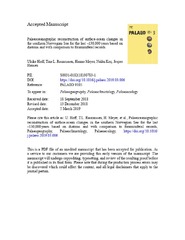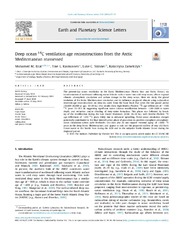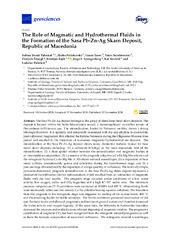Artikler, rapporter og annet (geovitenskap): Nye registreringer
Viser treff 541-560 av 825
-
Palaeoceanographic reconstruction of surface-ocean changes in the southern Norwegian Sea for the last ~130,000 years based on diatoms and with comparison to foraminiferal records
(Journal article; Tidsskriftartikkel; Peer reviewed, 2019-03-28)Fossil marine diatom assemblages in a sediment core from the central northern Faroe slope in the Norwegian Sea were used to reconstruct palaeoceanographic changes in the surface water mixed layer from the last ~130,000 years (Marine Isotope Stage (MIS) 6/5 transition to MIS 1 (including the Eemian and Holocene interglacials) and to compare the results with previously published results on planktic ... -
Morphological evidence for marine ice stream shutdown, central Barents Sea
(Journal article; Tidsskriftartikkel; Peer reviewed, 2019-05-02)Marine-based ice streams are responsible for a significant proportion of the ice mass loss from the present-day Greenland Ice Sheet, East Antarctic Ice Sheet (EAIS) and West Antarctic Ice Sheet (WAIS) but the processes controlling their initiation, evolution and shutdown remain elusive, hindering our understanding of how existing ice masses will respond to predicted future warming. The exposed beds ... -
Reviewing the Cenozoic Net Erosion of the Barents Sea Shelf
(Conference object; Konferansebidrag, 2019-01) -
Evidence of Isotopic Fractionation During Vapor Exchange Between the Atmosphere and the Snow Surface in Greenland
(Journal article; Tidsskriftartikkel; Peer reviewed, 2019-02-18)Several recent studies from both Greenland and Antarctica have reported significant changes in the water isotopic composition of near‐surface snow between precipitation events. These changes have been linked to isotopic exchange with atmospheric water vapor and sublimation‐induced fractionation, but the processes are poorly constrained by observations. Understanding and quantifying these processes ... -
Fracture-controlled fluid transport supports microbial methane-oxidizing communities at Vestnesa Ridge
(Journal article; Peer reviewed, 2019-05-29)We report a rare observation of a mini-fracture in near-surface sediments (30 cm below the seafloor) visualized using a rotational scanning X-ray of a core recovered from the Lomvi pockmark, Vestnesa Ridge, west of Svalbard (1200 m water depth). Porewater geochemistry and lipid biomarker signatures revealed clear differences in the geochemical and biogeochemical regimes of this core compared with ... -
Organic Matter Sources in North Atlantic Fjord Sediments
(Journal article; Tidsskriftartikkel; Peer reviewed, 2019-05-31)To better constrain the global carbon cycle fundamental knowledge of the role of carbon cycling on continental margins is crucial. Fjords are particularly important shelf areas for carbon burial due to relatively high sedimentation rates and high organic matter fluxes. As terrigenous organic matter is more resistant to remineralization than marine organic matter, a comprehensive knowledge of the ... -
Constraints on Gas Hydrate Distribution and Morphology in Vestnesa Ridge, Western Svalbard Margin, Using Multicomponent Ocean‐Bottom Seismic Data
(Journal article; Tidsskriftartikkel; Peer reviewed, 2019-04-26)Gas hydrates occur within sediments on the western Svalbard continental margin and the Vestnesa Ridge, a large sediment drift that extends in a west‐north‐west direction from the margin towards the mid‐ocean ridge. We acquired multi‐component ocean‐bottom seismic (OBS) data at ten locations on the crest area of the eastern segment of the Vestnesa Ridge, an area with active gas seepage. P and S‐wave ... -
Deep ocean 14C ventilation age reconstructions from the Arctic Mediterranean reassessed
(Journal article; Tidsskriftartikkel; Peer reviewed, 2019-05-13)The present-day ocean ventilation in the Arctic Mediterranean (Nordic Seas and Arctic Ocean), via transformation of northward inflowing warm Atlantic surface water into cold deep water, affects regional climate, atmospheric circulation and carbon storage in the deep ocean. Here we study the glacial evolution of the Arctic Mediterranean circulation and its influence on glacial climate using ... -
Formation Conditions and 40Ar/39Ar Age of the Gem-Bearing Boqueirão Granitic Pegmatite, Parelhas, Rio Grande do Norte, Brazil
(Journal article; Peer reviewed, 2019-04-15)The Boqueirão granitic pegmatite, alias Alto da Cabeça pegmatite, is situated in Borborema Pegmatitic Province (BPP) in Northeast Brazil. This pegmatitic province hosts globally important reserves of tantalum and beryllium, as well as significant quantities of gemstones, including aquamarine, morganite, and the high-quality turquoise-blue “Paraíba Elbaite”. The studied lithium-cesium-tantalum Boqueirão ... -
The Role of Magmatic and Hydrothermal Fluids in the Formation of the Sasa Pb-Zn-Ag Skarn Deposit, Republic of Macedonia
(Journal article; Peer reviewed, 2018-11-29)The Sasa Pb-Zn-Ag deposit belongs to the group of distal base metal skarn deposits. The deposit is located within the Serbo-Macedonian massif, a metamorphosed crystalline terrain of Precambrian to Paleozoic age. The mineralization, hosted by Paleozoic marbles, shows a strong lithological control. It is spatially and temporally associated with the calc-alkaline to shoshonitic post-collisional magmatism ... -
Postglacial relative sea level change and glacier activity in the early and late Holocene: Wahlenbergfjorden, Nordaustlandet, Svalbard
(Journal article; Peer reviewed, 2019-05-01)Sediment cores from Kløverbladvatna, a threshold lake in Wahlenbergfjorden, Nordaustlandet, Svalbard were used to reconstruct Holocene glacier fluctuations. Meltwater from Etonbreen spills over a threshold to the lake, only when the glacier is significantly larger than at present. Lithological logging, loss-on-ignition, ITRAX scanning and radiocarbon dating of the cores show that Kløverbladvatna ... -
Methane release from pingo-like features across the South Kara Sea shelf, an area of thawing offshore permafrost
(Journal article; Tidsskriftartikkel; Peer reviewed, 2015-07-16)The Holocene marine transgression starting at ~19 ka flooded the Arctic shelves driving extensive thawing of terrestrial permafrost. It thereby promoted methanogenesis within sediments, the dissociation of gas hydrates, and the release of formerly trapped gas, with the accumulation in pressure of released methane eventually triggering blowouts through weakened zones in the overlying and thinned ... -
A new numerical model for understanding free and dissolved gasprogression toward the atmosphere in aquatic methane seepage systems
(Journal article; Tidsskriftartikkel; Peer reviewed, 2019-01-16)We present a marine two‐phase gas model in one dimension (M2PG1) resolving interaction between the free and dissolved gas phases and the gas propagation toward the atmosphere in aquatic environments. The motivation for the model development was to improve the understanding of benthic methane seepage impact on aquatic environments and its effect on atmospheric greenhouse gas composition. Rising, ... -
Direct 40Ar/39Ar K‐feldspar dating of Late Permian–Early Triassic brittle faulting in Northern Norway
(Journal article; Tidsskriftartikkel; Peer reviewed, 2018-04-23)While the offshore post‐Caledonian extensional history of the north Norwegian passive margin is well constrained, the tectonic relationship between onshore and offshore regions is less clear because of limited age constraints on the timing of rifting onshore. <sup>40</sup>Ar/<sup>39</sup>Ar dating of K‐feldspar from hydrothermally altered fault rocks in a Precambrian gneiss complex in northern Norway ... -
The dinoflagellate cyst genera Achomosphaera Evitt 1963 and Spiniferites Mantell 1850 in Pliocene to modern sediments: a summary of round table discussions
(Journal article; Tidsskriftartikkel; Peer reviewed, 2018-12-14)We present a summary of two round-table discussions held during two subsequent workshops in Montreal (Canada) on 16 April 2014 and Ostend (Belgium) on 8 July 2015. Five species of the genus <i>Achomosphaera</i> Evitt 1963 and 33 of the genus <i>Spiniferites</i> Mantell 1850 emend. Sarjeant 1970 occuring in Pliocene to modern sediments are listed and briefly described along with remarks made by ... -
On the causes of Arctic sea ice in the warm Early Pliocene
(Journal article; Tidsskriftartikkel; Peer reviewed, 2019-01-30)Scattered and indirect evidence suggests that sea ice occurred as far south as the Iceland Sea during the Early Pliocene, when the global climate was warmer than present. However, conclusive evidence as well as potential mechanisms governing sea ice occurrence outside the Arctic Ocean during a time with elevated greenhouse gas concentrations are still elusive. Here we present a suite of organic ... -
Greenland Ice Sheet surface melt amplified by snowline migration and bare ice exposure
(Journal article; Tidsskriftartikkel; Peer reviewed, 2019-03-06)Greenland Ice Sheet mass loss has recently increased because of enhanced surface melt and runoff. Since melt is critically modulated by surface albedo, understanding the processes and feedbacks that alter albedo is a prerequisite for accurately forecasting mass loss. Using satellite imagery, we demonstrate the importance of Greenland’s seasonally fluctuating snowline, which reduces ice sheet albedo ... -
Authigenesis of biomorphic apatite particles from Benguela upwelling zone sediments off Namibia: The role of organic matter in sedimentary apatite nucleation and growth
(Journal article; Tidsskriftartikkel; Peer reviewed, 2018-07-30)Sedimentary phosphorites comprise a major phosphorus (P) ore, yet their formation remains poorly understood. Extant polyphosphate‐metabolizing bacterial communities are known to act as bacterial phosphate‐pumps, leading to episodically high dissolved phosphate concentrations in pore waters of organic‐rich sediment. These conditions can promote the precipitation of amorphous precursor phases that are ... -
Reconstruction of ice sheet retreat after the Last Glacial maximum in Storfjorden, southern Svalbard
(Journal article; Tidsskriftartikkel; Peer reviewed, 2018-12-15)Storfjorden is a large north-south trending sound located in the southern part of Svalbard in the northwestern Barents Sea. Presently, several glaciers drain into the northern and western part of Storfjorden. Our study area covers the southern part of the sound, which is divided by a north-south striking basement ridge (the ‘Mid-ridge’) into a narrow western trough (‘Little-Storfjorden’) and a broader ... -
Multiple sulphur isotope records tracking basinal and global processes in the 1.98 Ga Zaonega Formation, NW Russia
(Journal article; Tidsskriftartikkel; Peer reviewed, 2018-09-19)The exceptionally organic-rich rocks of the 1.98 Ga Zaonega Formation deposited in the Onega Basin, NW Russia, have refined our understanding of Earth System evolution during the Paleoproterozoic rise in atmospheric oxygen. These rocks were formed in vent- or seep influenced settings contemporaneous with voluminous mafic volcanism and contain strongly <sup>13</sup>C-depleted organic matter. ...


 English
English norsk
norsk


















